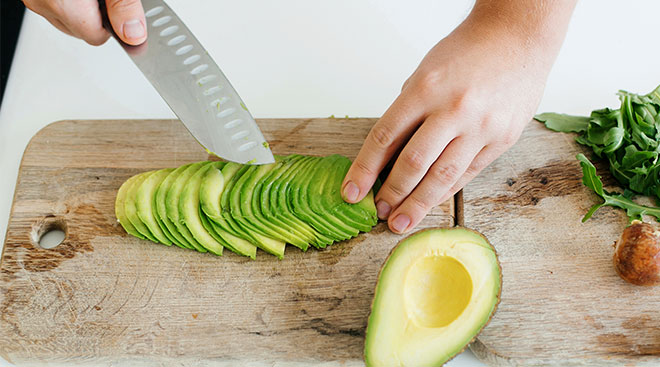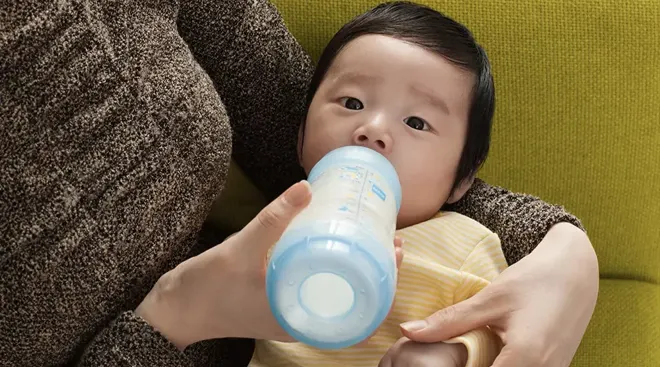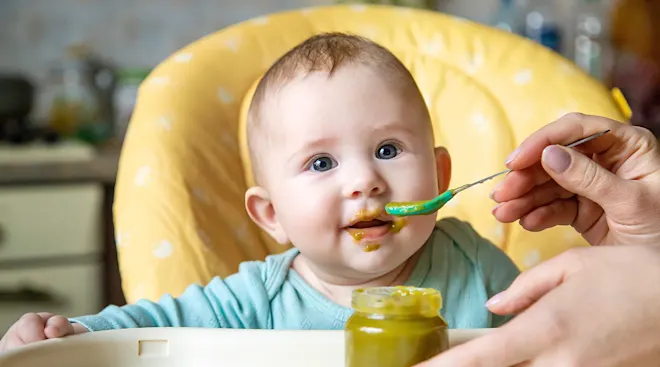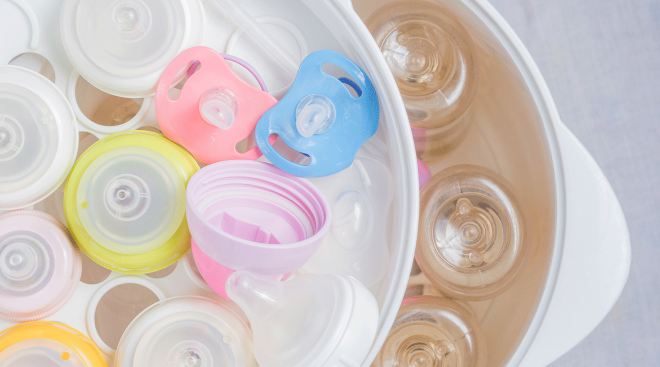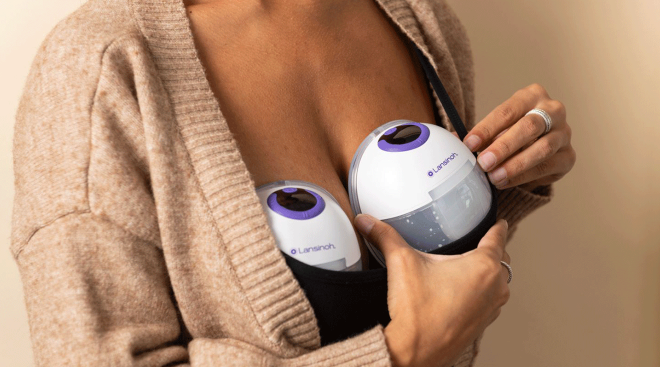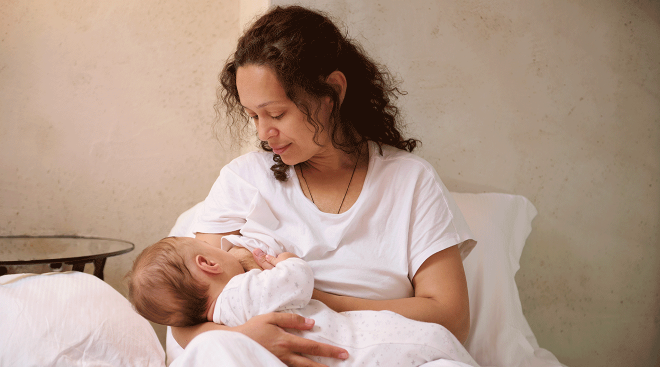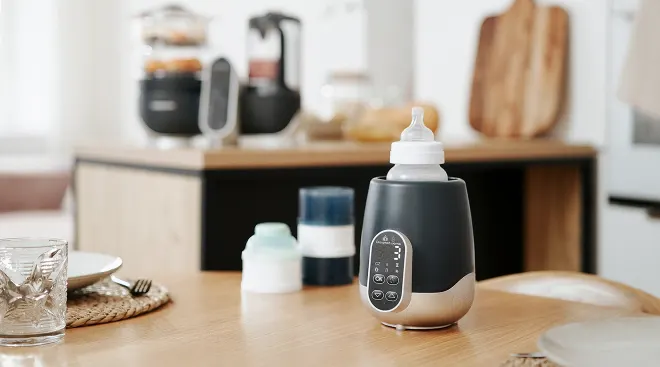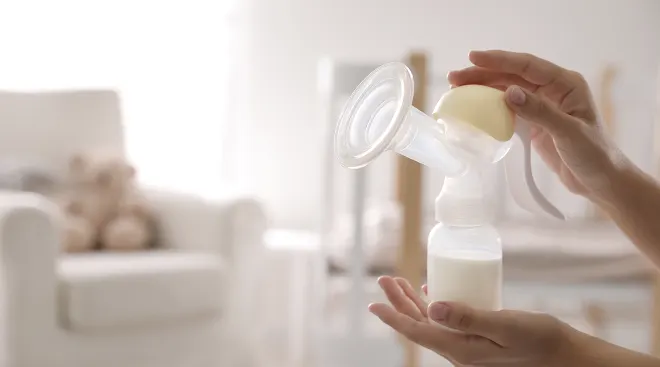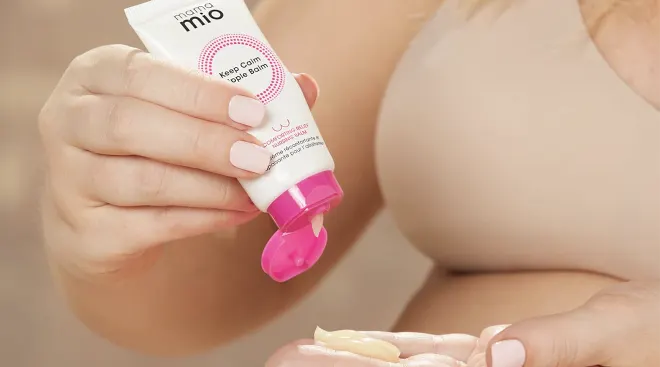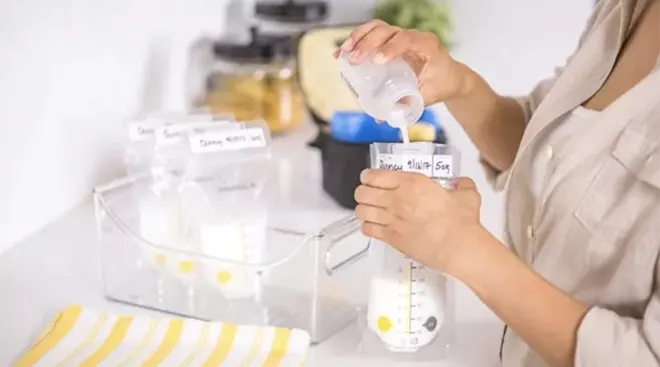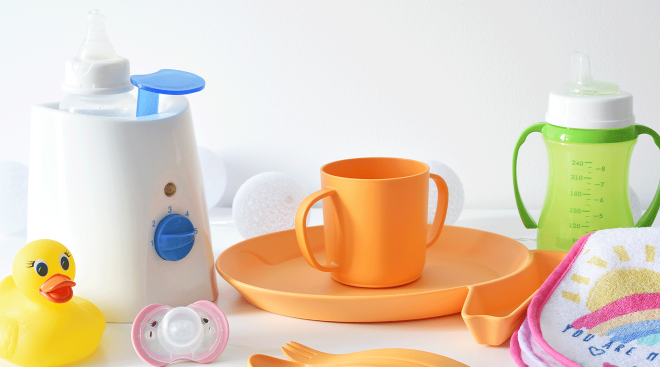Rethinking Baby Food: What to Know About Baby-Led Weaning
When Christa Terry’s son Hunter was ready to start solid foods, she loaded up her shopping cart with jars of strained vegetables and fruits. She definitely wasn’t expecting Hunter’s first mealtimes to turn into baby food battles, but he responded by spitting each bite out.
“He did not care for the texture,” says Terry, of Beverly, Massachusetts, who runs the social networking site mommeetmom.com. “So we just said, ‘Okay if that’s what you want, you’ll eat what we eat.’” So when 8-month-old Hunter grabbed for the pickled ginger at a sushi restaurant, Terry didn’t stop him. Next came homemade quiches and curries, in which, Terry notes, “the vegetables would be just soft enough that he could eat them.”
As Hunter grew bigger, Terry continued to let him have whatever the family was eating at the time. By 13 months old, Hunter’s day was starting with a waffle, honeydew and a cheese stick. Whether she realized it at the time or not, Terry had been practicing what author and midwife Gill Rapley first dubbed “baby-led weaning.”
So what exactly is baby-led weaning, and should you be introducing it to your child? Read on for the full scoop on this feeding approach to figure out if your little one is destined to become a BLW baby.
Baby-led weaning, also sometimes simply referred to as BLW, is a process that follows baby’s cues while introducing them to table foods that the whole family eats. The practice of baby-led weaning allows baby to self-feed finger foods as their first solid food rather than the more traditional rice, oatmeal or fruit and vegetable purees.
Many American parents associate the term “weaning” with easing baby off of breast milk or formula, but BLW is all about adding solid foods into baby’s diet, not taking milk or formula away (at least not right away). In fact, baby should still be getting the majority of their calories and nutrients from breast milk or formula until they turn one year old.
Aside from the obvious—no more special meals for baby!—there are numerous benefits of baby-led weaning. “Babies fed this way are more likely to have a balanced diet, because they’re not limited to just fruits and vegetables,” says Rapley, coauthor of the book Baby-Led Weaning: The Essential Guide. She goes on to say, “I found that the solution to baby refusing food or being picky about what they would eat was just to let them feed themselves.” Other benefits of baby-led weaning include:
- Saves money on store-bought baby food
- Develops hand-eye coordination in baby
- Introduces baby to a wide variety of food
- Teaches baby early decision-making skills
- Encourages healthier eating for the whole family
Wondering when to start baby-led weaning? Generally, experts recommend introducing solid foods when baby is between 4 and 6 months old, depending on their individual development. But there’s no magic age that you need to wait for to start BLW in particular—you’ll just want to look for the following signs of readiness:
• Baby seems interested in your food. When baby begins to reach for and grab food off others’ plates, they’re showing they understand what food is and what to do with it.
• Baby has a pincer grasp. Sometime after 6 months of age, baby’s fine motor skills will progress to the point where they can take their chubby little thumb and forefinger and pick up a single, tiny object (like a Cheerio). This is called a pincer grasp, and it’s a developmental milestone that baby will use for tasks like eating and brushing teeth.
• Baby can sit up without support. It’s unsafe to begin baby-led weaning if baby is still prone to flopping onto their side or—even more dangerous—falling over backward, since this is a choking hazard.
• Baby has lost the tongue-thrust reflex. Before 6 months of age, baby’s tongue will thrust forward and push foreign objects out of their mouth reflexively. Once this reflex fades, baby can begin self-feeding.
Once baby meets the requirements listed above, it’s time to get started! Don’t sweat—the BLW process is quite simple, and you won’t need any special baby-led weaning foods or equipment. When thinking about how to start baby-led weaning, just a bit of forethought while prepping for each meal is all that’s needed. If you’re having chicken for dinner, cut it up into small pieces for baby. Steam carrots until they’re soft or cut up raw fruits and vegetables such as cucumbers or strawberries that can be easily mashed by toothless jaws but enjoyed as part of a salad for the rest of the family. You can also let baby dive into a baked potato or pick up handfuls of spaghetti.
“If babies don’t experiment with food, they might miss that learning opportunity about eating,” says Eileen Behan, RD, author of The Baby Food Bible. “That might add to somebody becoming a picky eater.”
Of course, baby-led weaning will be messy. But so much about babyhood is! By letting baby explore food in this way and on their own terms, you may see the BLW benefits later on. Remember, even baby’s earliest meals are helping them form long-term tastes and nutritional habits. So if you’re going to serve baby the same meal that you’re eating, ensure it’s a healthy, balanced one.
The main concern nutrition experts have about baby-led weaning foods is salt and sugar intake, says Behan. “Are Mom and Dad making their own food or are they buying canned or processed foods?” she says. Too much sodium creates a taste for sodium that babies don’t need, and it could affect their blood pressure.
For baby’s optimal health and comfort as you begin baby-led weaning, foods to avoid include:
- processed foods
- foods with lots of sodium
- fast food
- spicy food
Aside from these restrictions, as long as you’re vigilant about foods that could be choking hazards, you can feed baby pretty much anything during baby-led weaning.
For many parents considering baby-led weaning, choking is their top concern. In a way, baby-led feeding goes against everything we’ve been taught about babies and small objects. But rest assured that by following a few simple baby-led weaning tips, parents can keep the risk of choking at bay. In fact, a 2016 study from the American Academy of Pediatrics (AAP) found that BLW babies weren’t any more likely to choke than babies fed traditional purees.
That said, the study also found that regardless of whether they were fed baby-led weaning foods or not, babies were still offered bites that could pose a choking hazard. To avoid choking, the AAP advises against giving a child 12 months or younger any food that requires chewing. When you try baby-led weaning, foods to avoid for risk of choking include:
- hot dogs
- nuts and seeds
- chunks of meat or cheese
- whole grapes
- popcorn
- raw vegetables
- anything diced too small, like fruit chunks
- hard, gooey or sticky candy
- honey (it also poses a risk of infant botulism)
Aside from not giving baby those foods, here are some additional safety tips to consider when you have a BLW baby on your hands:
- Give baby safe, baby-led weaning foods (listed out below)
- Encourage baby to sit in an upright position at the table while eating
- Always supervise baby when they’re eating
- Avoid distractions that could cause baby to choke, such as trying to make baby laugh or letting them wriggle around excessively
- Take CPR lessons and request for your caregivers to do the same. Accidents happen, so it’s always best to be prepared
- Allow baby to explore their gag reflex on their own, but know how to tell the difference between gagging and choking
So is baby-led weaning safe? It is as long as parents are vigilant. Be alert to choking, but realize that there’s a difference between gagging and choking. Choking is when a piece of food partially or completely blocks baby’s airway. They’ll have trouble coughing and breathing; choking is usually silent. Gagging, on the other hand, is a normal reflex and quite common as babies learn to chew and swallow. Baby’s throat contracts and their tongue pushes to the front of the mouth to get rid of the offending food. “The gag reflex is triggered very readily, well before anything gets anywhere near the airway,” says Rapley. “It may even be a sort of safety feature.” They may cough, sputter and make gagging noises and may even vomit the food up.
But that gag reflex doesn’t mean you should give up on baby-led weaning. “A lot of kids go through a period of doing quite a lot of gagging at first,” notes Rapley. “But they just seem to manage to work their way through it and they don’t seem bothered by it.”
Rapley suggests that, at least initially, mealtime should feel like playtime to baby. Given that your little one will still be getting the majority of their nutrition from breast milk or formula, mealtime should be more about learning about and exploring food than caloric intake. Some of the best baby-led weaning foods are those that are soft and easy to mash up, and therefore—you guessed it—messy! Ready to start prepping food for your BLW baby? Check out these tasty baby-led weaning foods below:
Fruit:
- Bananas (cut into thirds with peel partially removed, to serve as handle)
- Sliced strawberries
- Mushed berries
- Sliced orange wedges (without seeds)
- Sliced avocados
Veggies:
- Steamed broccoli florets
- Steamed carrot strips
- Baked sweet potato wedges
- Steamed green beans and peas
- Sliced tomatoes
Protein:
- Cut-up or shredded chicken
- Quartered hard-boiled eggs
- Tofu strips
- Shredded boiled beef
- Ground beef casserole
Grains:
- Spaghetti
- Whole wheat toast cut into strips
- Bagel with hummus or cream cheese
Dairy:
- Cottage cheese
- Plain or Greek yogurt
- Shredded full-fat mozzarella or swiss cheese
As you begin introducing BLW, you’ll continue breast- or bottle-feeding as usual but add in opportunities for baby to explore new foods at breakfast, lunch and dinner time. So what does that new daily routine actually look like? Every family’s day will look a little different, of course, but to help you introduce baby-led weaning, consider these sample feeding schedules based on baby’s age.
6-8 month baby feeding schedule (assuming 3 naps)
7 a.m.: Wake up and nurse or bottle-feed
8 a.m.: Breakfast (e.g., soft fruits and yogurt)
8:30-10:30 a.m.: Nap
10:30 a.m.: Wake up and nurse or bottle-feed
12:30 p.m.-2:30 p.m.: Nap
2:30 p.m.: Nurse or bottle-feed
4:30-5 p.m.: Quick nap
5 p.m.: Wake up and nurse or bottle feed
5:45 p.m.: Dinner (e.g., soft veggies and protein)
6:45 p.m.: Nurse or bottle feed
7 p.m.: Bedtime
9-12 month baby feeding schedule (assuming two naps)
7 a.m.: Wake up and nurse or bottle-feed
8 a.m.: Breakfast (e.g., soft fruits and hard-boiled eggs)
10-11:30 a.m.: Nap
11:30 a.m.: Wake up and nurse or bottle feed
12:30 a.m.: Lunch (e.g., whole wheat bread with hummus and avocado slices)
2:30-4 p.m.: Nap
4 p.m.: Nurse or bottle-feed
5:45 p.m.: Dinner (e.g., soft veggies and protein)
6:45 p.m.: Nurse or bottle feed
7 p.m.: Bedtime
About the experts:
Gill Rapley, PhD, MSc, RGN, RM, RHV, is internationally known as the pioneer of the baby-led weaning method and has more than 35 years of experience in the field of infant feeding. She is the author of Baby-Led Weaning: The Essential Guide, among several other baby feeding books, as well as a public health nurse, midwife and lactation consultant.
Eileen Behan, RD, is a registered dietician with more than 25 years of experiencing working with families. She is the author of The Baby Food Bible: A Complete Guide to Feeding Your Child, From Infancy On—one of 9 books she’s published on family nutrition. She is also the founder of the education program For the Love of Food project.
Please note: The Bump and the materials and information it contains are not intended to, and do not constitute, medical or other health advice or diagnosis and should not be used as such. You should always consult with a qualified physician or health professional about your specific circumstances.
Plus, more from The Bump:
Navigate forward to interact with the calendar and select a date. Press the question mark key to get the keyboard shortcuts for changing dates.
































